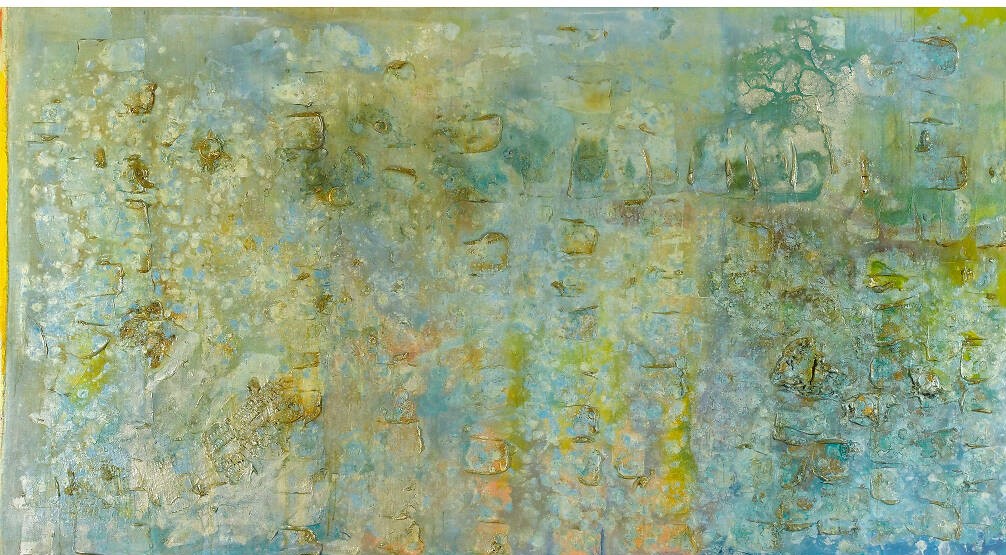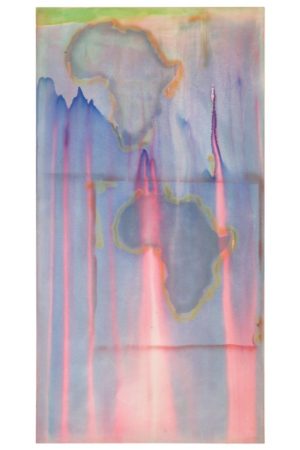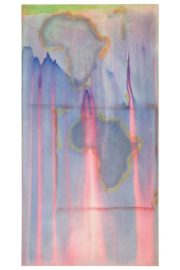Frank Bowling at the Tate Britain

At 85, Guyanese-British painter Frank Bowling is finally being given a retrospective of his career by the Tate Britain. The exhibition, chronicling six decades of creativity and featuring some 70 pieces, focuses mainly on his large paintings and archive material. A contemporary of Hockney at the Royal College of Art, the subject became the first black artist to be elected a Royal Academician in 2005.
Bowling emigrated from Guyana to London at the age of 19, where he gained a scholarship to the Royal College at a time when Pop Art was leaving its mark on British art. However, it was Francis Bacon’s visceral imagery which first inspired the artist, as is evident in the younger man’s 1961 painting Birthday at the start of this exhibition. Here he captures the agonising cries of his neighbour giving birth, witnessed through a window.
One early piece, Cover Girl (1966) sees Bowling incorporating Pop Art imagery. He juxtaposes a screen-print of his mother’s shop in Guyana – a regular motif in early canvases – with an image painted from the cover of the Observer Magazine of a model, Hiroko Matsumoto. She wears a geometric Pierre Cardin dress and Vidal Sassoon hair.
Mirror (1964-6) also possesses a personal narrative. It features the staircase between the old Royal College painting school and the V&A, remembered by the painter as a student escape route. It was also for him a metaphor for artists’ career tendencies to rise to prominence or disappear into obscurity. His then-wife, Patty Kitchen, descends while Bowling’s own image at the bottom is seemingly fading. Stylistically, he intended to “marry up” disparate techniques in the painting.
In 1966, the artist moved to New York, keen to participate in the Civil Rights movement. He would immerse himself in the city’s art scene as a painter, curator and a writer of influential articles about Black art for Arts Magazine from 1969-72. America palpably emboldened his colours and determination to experiment, with the Whitney Gallery awarding him a major solo show in 1971. Ten of the artist’s heralded “Map Paintings” created during these years are here, including Who’s Afraid of Barney Newman (1968). As much as seven metres in length, the works feature the outlines of continents, especially Africa and South America, stencilled and sprayed onto fields of colour. Bowling is considering themes of post-colonialism and his own Afro-Caribbean roots.
The Tate curators have devoted another room to Bowling’s admired “Poured Paintings”. In New York he was exposed to Abstract Expressionism, befriending the critic Clement Greenberg. An inspired Bowling devised a tilting platform which allowed him to pour acrylic paint onto canvasses from a height of up to 2 metres. The resulting angle caused the rich colours to slowly cascade to the bottom in dramatic works such as Ziff (1974) and Tony’s Anvil (1975).
In 1975, Bowling moved back to London to spend more time with his family, although since 1990 he has continued to use both his studios in London and New York. From the 1980s, the visitor sees two large-scale paintings from his “Great Thames” series (1988-89), each evoking the play of sunlight on the Thames, along with the river’s undulating riverbeds. Each recall two of his heroes, Turner and Constable. These are densely textured surfaces, incorporating found objects together with metallic pigments, gels and chalks. Following his mother’s death in 1988, Bowling made an emotional trip back to Guyana with his son, Sacha, inspiring his vibrant work, Sacha Jason Guyana Dreams (1989).
Based in London once again, Bowling still regularly works in his South London studio. His declining physical abilities mean that he now has to instruct assistants, including his grandson Frederik, from a seated position to drip and pour paint over canvases. Throughout his life, the artist has pursued his own visions, the final room at the Tate Gallery revealing exhilarating recent works like Remember Thine Eyes (2014) and Wafting (2018), still crackling with experimental energy.
James White
Featured Image: Great Thames IV, 1988-9 © Frank Bowling, DACS 2019/Courtesy of Tate
Frank Bowling is at the Tate Britain from 31st May until 26th August 2019. For further information visit the exhibition’s website here.




















Facebook
Twitter
Instagram
YouTube
RSS